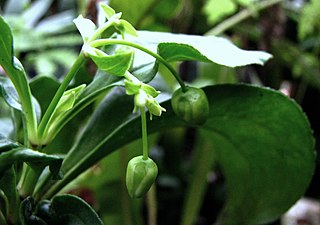
Gunnera is the sole genus of herbaceous flowering plants in the family Gunneraceae, which contains 63 species. Some species have extremely large leaves. Species in the genus are variously native to Latin America, Australia, New Zealand, Papuasia, Hawaii, insular Southeast Asia, Africa, and Madagascar. The stalks of many species are edible.

Osmunda regalis, or royal fern, is a species of deciduous fern, native to Europe, Africa and Asia, growing in woodland bogs and on the banks of streams. The species is sometimes known as flowering fern due to the appearance of its fertile fronds.

Gunnera manicata, known as Brazilian giant-rhubarb or giant rhubarb, is a species of flowering plant in the family Gunneraceae from Brazil.

Gunnera tinctoria, known as giant rhubarb or Chilean rhubarb, is a flowering plant species native to southern Chile and neighbouring zones in Argentina. It is unrelated to rhubarb, as the two plants belong into different orders, but looks similar from a distance and has similar culinary uses. It is a large-leaved perennial plant that grows to more than two metres tall. It has been introduced to many parts of the world as an ornamental plant and in some countries it has spread from gardens and is becoming a weed problem. It is known under the synonyms: Gunnera chilensis Lam. and Gunnera scabra Ruiz & Pav.
Tovomita aequatoriensis is a species of flowering plant in the family Clusiaceae. It is found only in Ecuador. Its natural habitat is subtropical or tropical moist lowland forest. The only threat known so far is habitat destruction.

The equatorial dog-faced bat is a species of bat in the family Molossidae. It is endemic to Ecuador. They are found in dry, tropical forests. The species is now endangered. The equatorial dog-faced bat feeds on insects.

Alsinidendron trinerve, also called three nerved alsinidendron, is a species of flowering plant in the family Caryophyllaceae, that is endemic to island of Oʻahu in Hawaii. It is a subshrub, reaching a height of 30–80 cm (12–31 in).
Lachemilla aequatoriensis is a species of plant in the family Rosaceae. It is endemic to Ecuador.
Saurauia aequatoriensis is a species of plant in the Actinidiaceae family. It is endemic to Ecuador. Its natural habitat is subtropical or tropical moist montane forests. It is threatened by habitat loss.

The World's 25 Most Endangered Primates is a list of highly endangered primate species selected and published by the International Union for Conservation of Nature (IUCN) Species Survival Commission (SSC) Primate Specialist Group (PSG), the International Primatological Society (IPS), Global Wildlife Conservation (GWC), and Bristol Zoological Society (BZS). The IUCN/SSC PSG worked with Conservation International (CI) to start the list in 2000, but in 2002, during the 19th Congress of the International Primatological Society, primatologists reviewed and debated the list, resulting in the 2002–2004 revision and the endorsement of the IPS. The publication was a joint project between the three conservation organizations until the 2012–2014 list when BZS was added as a publisher. The 2018–2020 list was the first time Conservation International was not among the publishers, replaced instead by GWC. The list has been revised every two years following the biannual Congress of the IPS. Starting with the 2004–2006 report, the title changed to "Primates in Peril: The World's 25 Most Endangered Primates". That same year, the list began to provide information about each species, including their conservation status and the threats they face in the wild. The species text is written in collaboration with experts from the field, with 60 people contributing to the 2006–2008 report and 85 people contributing to the 2008–2010 report. The 2004–2006 and 2006–2008 reports were published in the IUCN/SSC PSG journal Primate Conservation,, since then they have been published as independent publications.
Maculatifrondes is a genus of fungi in the order Phyllachorales. This is a monotypic genus, containing the single species Maculatifrondes aequatoriensis. The fungus, first discovered in Ecuador, is associated with leaf spot of palms.

Gunnera monoica is a species of Gunnera endemic to New Zealand. It is one of the smallest species of Gunnera, with leaves of around 3 cm (1.2 in) wide. It spreads by forming stolons in damp ground.
Pfarmers is an American experimental supergroup, made up of Danny Seim, Bryan Devendorf, and Dave Nelson.

Gunnera petaloidea is a species of Gunnera endemic to Hawaii on the islands Oahu, Molokai, Maui, and Hawaii. It is found on slopes which receive torrential precipitation at an altitude between 2,500–5,000 feet (760–1,520 m). The Hawaiian name for this plant is Apé or Apé-Apé.

Gunnera macrophylla, is a species of Gunnera found in Papuasia, Indonesia, and the Philippines.

Gunnera perpensa, is a species of Gunnera found in Madagascar.

Gunnera mexicana, is a species of Gunnera found in Vera Cruz, Mexico.
Gunnera mixta is a species of Gunnera native to New Zealand.












